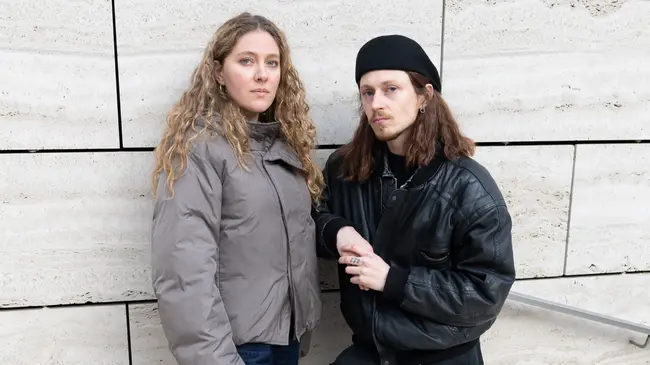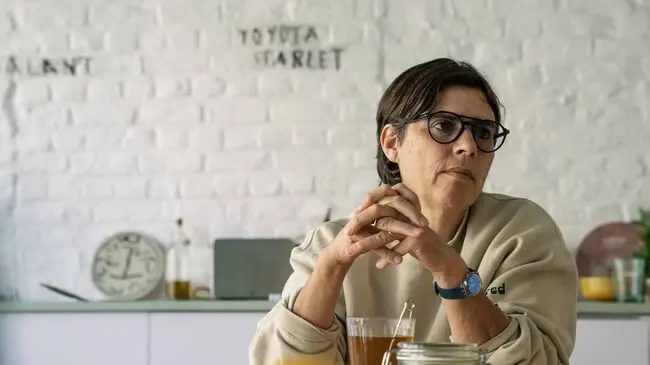Brush to Matter: Provoking Change with Antoni Tàpies

Carmen Pazos, a Spanish-born artist based in Brussels, reflects on revisiting the work of Antoni Tàpies at Bozar. Her journey reveals newfound nuances in his work, drawing parallels within her own artistic process and emphasising the power of materials and the resonance of societal denunciation in art.
Given your background, have you seen works of Tàpies in Spain? How was it revisiting his work in Brussels?
As he is very famous in Spain, I have seen many reproductions of his work before. Still, it wasn’t until I visited Barcelona for my 19th birthday that I saw his work for the first time at the Fundacio Tàpies. I have a memory of the strong impression of all these collages with different objects left. Everything was massive and it felt dark and dense. Seeing his work now, I can see more nuances and depths than I did 10 years ago. I feel a lot of affinity between my work and his work, especially this year when I began working more with raw materials and texture. I am very interested in working with natural materials, so I found his use of wood, soil, and rocks magnificent. It was very inspiring.
I feel a lot of affinity between my work and his work, especially this year when I began working more with raw materials and texture
<img class="editorial-image-50-left" src="https://cdn.prod.website-files.com/61eebcc683107b99137f4423/655b4635c059a3c374dd8055_differentclassDC_BOZAR_CARMEN-52-2-min.webp"/>
<img class="editorial-image-50-right" src="https://cdn.prod.website-files.com/61eebcc683107b99137f4423/655b46346c7b81432a327815_differentclassDC_BOZAR_CARMEN-26-2-min.webp"/>
What were your initial impressions upon visiting this expo?
I thought Bozar did a great job showing his artistic development. In other exhibitions, I have seen the works he is most known for, which are very impressive, but here, they exhibited his work in a progression from his youth until his material work and experiments that most people are familiar with. I was introduced to his work on paper during the visit. It is like a behind-the-scenes of his big paintings.
<img class="editorial-image-50-left" src="https://cdn.prod.website-files.com/61eebcc683107b99137f4423/655b4635596fc5649b568f83_differentclassDC_BOZAR_CARMEN-48-2-min.webp"/>
<img class="editorial-image-50-right" src="https://cdn.prod.website-files.com/61eebcc683107b99137f4423/655b463485149b879b7e0bde_differentclassDC_BOZAR_CARMEN-45-2-min.webp"/>
As an artist, how does visiting exhibitions such as this one influence your creative process?
When I see work that I feel an affinity with, I get inspired by the feeling that someone else is reflecting on the same topics I do. Seeing the work of an artist transmit the kind of emotions I hope to visualize in my own work, although not necessarily in the same way, inspires me a lot. When I visit an exhibition that I connect strongly with, I just wanna get out and start working. I try to keep notes of the ideas that pop up while observing the works.
When I visit an exhibition that I connect strongly with, I just wanna get out and start working
<img class="editorial-image" src="https://cdn.prod.website-files.com/61eebcc683107b99137f4423/655b4635a2de4374969990eb_differentclassDC_BOZAR_CARMEN-34-2-min.webp"/>
How do you see Tàpies ideas on the human condition, politics and societal dynamics reflected in his work?
I feel that is somewhere where I felt related to him in a way. The exhibition touches on the civil war in Spain and how all the pain it caused affected him. I touch on this topic in one of my works, prompted by listening to the stories that my grandmothers told me about that time. When you are born in my generation in Spain, the older generations keep you at a distance from that time; they do not want to remember or talk about it. When they decided that I was old enough, they started to open up more. Then, you start to feel it is part of your history and legacy. In Tàpies’s work, you can feel that heaviness; sometimes as a painter, unless you are doing very strong figurative work, it is not easy to transmit the pain you feel when experiencing or hearing about conflicts of that kind. But he manages to do so through his work, for example, how Dukkha, transports you in a way to the feeling, not to a place or a figurative idea.
<img class="editorial-image-50-left" src="https://cdn.prod.website-files.com/61eebcc683107b99137f4423/655b4635c059a3c374dd80c6_differentclassDC_BOZAR_CARMEN-31-2-min.webp"/>
<img class="editorial-image-50-right" src="https://cdn.prod.website-files.com/61eebcc683107b99137f4423/655b463520add742f9c784da_differentclassDC_BOZAR_CARMEN-18-2-min.webp"/>
Do you agree with Tàpies’s idea of art as a tool of denunciation at the service of society?
I feel completely in line with that statement, as this is exactly how I feel about art. I think a lot of artists feel that they are powerless, especially when it comes to political matters. But at the end of the day when you look back at history, it is art that starts revolutions, it is art that starts movements. It is always mingled with the philosophy and political issues of each time. Especially artists that reflect on human struggles or even emotional struggles, should feel more powerful in that sense. They have a tool that allows us to create change. Moreover, creating a strong community of artists that share the same mindset is very important. This can be overlooked in our time because we feel very connected with social media. Still, at the end of the day, you need to show up in person and stage ideas together, as it can be very difficult to individually propel important transformation in the world.
It is art that starts revolutions, it is art that starts movements
<img class="editorial-image" src="https://cdn.prod.website-files.com/61eebcc683107b99137f4423/655b4635e7571c0eed2ad390_differentclassDC_BOZAR_CARMEN-51-2-min.webp"/>
What is something that you will take with you from this exhibition?
This visit gave me a stronger urge to experiment more with materiality. Since the beginning of this year I have been working with rice grains as a material for my work, something I was willing to do for the longest time but was too scared of stepping out of my two-dimensional work comfort zone. I feel a stronger motivation now to try more things, try different materials and continue with my own experiment.
<div class="editorial-banner"> <div class=“editorial-credits”> @carmenpazosmagar / @bozarbrussels </div></div>
Different Class works with the interest of their community at heart.
Our work’s purpose is to foster a solid network for independent artists, those who love them, and those who want to support them. Become a member to contribute to the local Belgian art scene.





